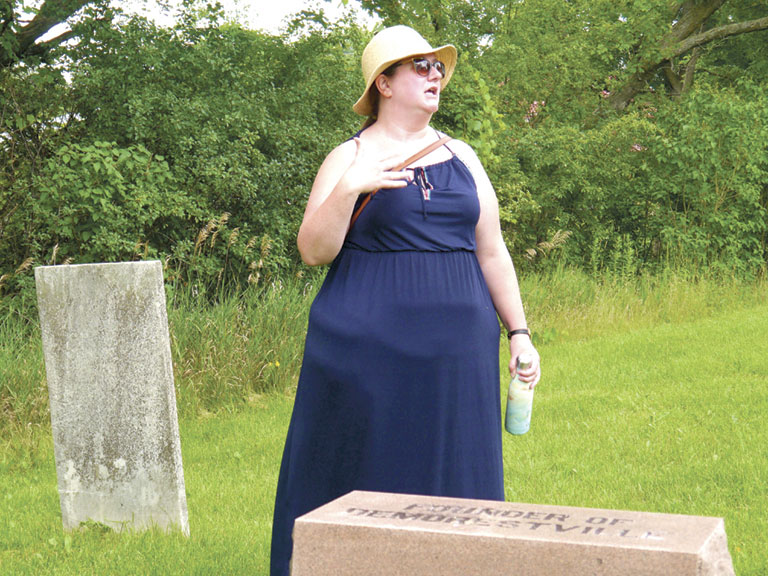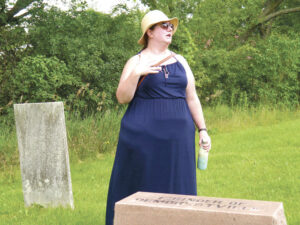County News
Walking tour

Demorestville’s beginnings and boom
Demorestville’s colourful, vibrant and profitable past was the topic of a Prince Edward County Past to Present walking tour series last Sunday hosted by the County Museums. While it is a quiet sleepy village now, the 1800s saw Demorestville as a booming hamlet, all thanks to its namesake, Guillame Demorest. He was an American, born in Duchess County, New York in 1769, and before he moved to Canada, first to Quebec, arriving in Prince Edward County in the 1790s. “As a man in his 20s, he is given land, or was able to secure land because of his service during the revolution, in what would become Demorestville,” explains tour guide Jessica Chase, also assistant curator with County Museums.
Chase says because Demorestville experienced its rise and fall so early on in the settler history of Prince Edward County, there is not much written about it. “The challenging thing about Demorestville is we don’t have many first-hand accounts of the interesting events that occurred when it was a really bustling spot,” says Chase. “As one of a number of prominent land owners in the area, Guillaume Demorest established a mill in 1800, and it’s why the town was named after him. Often, if you built the mill, your name went on the town,” she says. Chase describes Demorest as a man of all trades, including a Methodist minister overseeing early services in the village, but he was also listed as a Justice of the Peace and postmaster.

Tour guide Jessica Chase talks about some of Demorestville Cemetery’s important occupants, including the village’s founder, Guillaume Demorest.
By the 1820s, Demorestville was booming, largely because of the lumber industry. Samuel Munro arrived in the village at about the same time as Demorest and owned a general store across from the mill. “During those first few decades of the Loyalist settlement, lumber was the dominant industry here as the Loyalists worked to clear the land; it was natural that lumber would make them a lot of money,” adds Chase. “There were a lot of lumbermen coming into the town and you need hotels, you need taverns, you need lot of shops and carpenters and blacksmiths to service these people’s needs.” At its peak, there were three shoemakers, two milliners, a furniture maker, multiple blacksmiths and carpenters, a lumber yard and a ship building operation (even though it is four miles away from the bay), a doctor and a dispensary, tailors and dressmakers, and there was a band and a baseball team. “There was a lot going on, and with a population of around 400 it would have been a good-sized village in 1860 when it really reached its peak.” Demorest, however, passed away in 1848.
One of the reasons Demorestville started to decline was because it was not situated right on the water. The location Demorest had chosen for his mill had a 12-foot drop into the creek that came from Fish Lake. However, trying to ship goods to Muscote Bay and into the Bay of Quinte was a four-mile trek, so they either had to be barged down the creek, which is very narrow, or had to be taken overland. While the shipping industry was in decline, the railway was also to blame for Demorestville’s decline. Opening in Prince Edward County in 1879, there was no stop in Demorestville. The lumber industry was also beginning to slow. “Once the trees are cleared from his area, the lumber industry starts to decline and all of those lumbermen that have come into your community and stayed at your hotels and patronized your stores, they are now pulling out and leaving,” explains Chase. “All of a sudden, the transporting of items between Demorestville and the bay is starting to become more difficult compared to what it was before, especially when the railway was introduced.”
It was canning that would eventually replace these industries that had seen the last of the good times. “Canning in the County was born here in Demorestville, because the Boulter family were from here.” Montreal-born George Boulter was the first Boulter in the County in 1819.” Settling in Demorestville, he would have two wives and 21 children; his fourth son was Wellington Boulter, born 1838. “Wellington Boulter was the father of canning in Prince Edward County,” says Chase. In 1879, George Dunning, a fruit tree salesman in Prince Edward County got together with Boulter and therein began what was to become a significant and long-lived canning industry in the County.
A welcome side trip included an unexpected invitation inside the Friendship United Church (thanks to Reverend Barb and those getting ready for the first service in a long time due to the pandemic) which allowed a look at a mural painted by Ira Barton in 1873, who we later meet in the Demorestville Cemetery as the Bartons were a prominent early Demorestville family. While there was a chapel in Demorestville prior to 1873, the church itself was remodelled by a Picton construction firm that added the tower and spire, as well as 12-foot extension to the length of the building. Next door is the Town Hall, constructed in 1875. “It is really the most ornate, a little bit fancier then all the other town halls in the County, and it is has been called ‘overdressed’ in the past.”
The tour continued with a visit to the site of a former tavern built in 1826, which later became an inn, then a hotel, eventually burning down in 1900. “There were three taverns, possibly as many as seven, in the mid- 19th century,” Chase said. “All of those taverns led to a pretty bad reputation for Demorestville. And while everywhere had sordid tales and seedy stories, Demorestville was bad because lumber for the first 50 years was the go-to industry and it was a huge influx of men who were transient working in this industry and rough and tumble; we know there are accounts of people saying there was a prevalence of drunkenness among many of the locals.” Back up the hill is the Howell-Anderson house, “arguably the jewel of Demorestville” constructed in 1843 at the height of the Greek Revival in Canada, the doctor’s house opposite, and a little further down the footprint of a house constructed in 1856 for Ira Coolidge, a very successful hops buyer. The tour concludes at the Centre house, one of three houses built in 1841 in a row, known as the temple houses, again all in the Greek Revival style. “There’s so much history, if we peel back a few layers,” says Chase.

Comments (0)